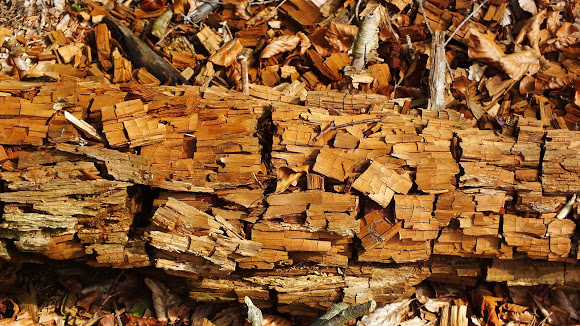Brown rot
A wood-decay fungus is any species of fungus that digests moist wood, causing it to rot. Some species of wood-decay fungi attack dead wood, such as brown rot, and some are parasitic and colonize living trees. Excessive moisture in wood is required for fungal colonization and proliferation. Fungi that not only grow on wood but permeate its fibrous structure and actually cause decay, are called lignicolous fungi. In nature, this process serves to break down complex molecules and return nutrients to the soil. Various lignicolous fungi consume wood in various ways; for example, some attack the carbohydrates in wood and some others decay lignin (structural materials in the support tissues of vascular plants). The rate of decay of wooden materials in various climates can be estimated by empirical models.
Wood-decay fungi can be classified according to the type of decay that they cause. The best-known types are brown rot, soft rot, and white rot. Each produce different enzymes, can degrade different plant materials, and can colonize different environmental niches.
Brown-rot fungi break down hemicellulose and cellulose that form the wood structure. In this type of decay, the wood shrinks, shows a brown discoloration, and cracks into roughly cubical pieces, a phenomenon termed cubical fracture. Brown-rot fungi of particular economic importance (3 main fungi) may attack timber in buildings. Dry rot is a generic name for certain species of brown-rot fungi.
There are very few brown rot fungi in tropical climates.
Soft-rot fungi leads to the formation of microscopic cavities inside the wood, and sometimes to a discoloration and cracking pattern similar to brown rot.
Soft-rot fungi are able to colonize conditions that are too hot, cold or wet for brown or white-rot to inhabit. They can also decompose woods with high levels of compounds that are resistant to biological attack. Bark in woody plants contains a high concentration of tannin, which is difficult for fungi to decompose, and suberin (waterproofing waxy substance) which may act as a microbial barrier.
White rots break down lignin and cellulose and commonly cause rotted wood to feel moist, soft, spongy, or stringy and appear white or yellow. There are many different enzymes that are involved in the decay of wood by white-rot fungi. White-rot fungi are grown all over the world as a source of food – for example the shiitake mushroom, which in 2003 comprised approximately 25% of total mushroom production.
Source wikipedia

